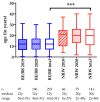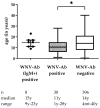Seroepidemiological Survey of West Nile Virus Infections in Horses from Berlin/Brandenburg and North Rhine-Westphalia, Germany
- PMID: 35215837
- PMCID: PMC8877243
- DOI: 10.3390/v14020243
Seroepidemiological Survey of West Nile Virus Infections in Horses from Berlin/Brandenburg and North Rhine-Westphalia, Germany
Abstract
Following the introduction of the West Nile virus (WNV) into eastern Germany in 2018, increasing infections have been diagnosed in birds, equines, and humans over time, while the spread of WNV into western Germany remained unclear. We screened 437 equine sera from 2018 to 2020, excluding vaccinated horses, collected from convenience sampled patients in the eastern and western parts of Germany, for WNV-specific antibodies (ELISAs followed by virus/specific neutralization tests) and genomes (RT-qPCRs). Clinical presentations, final diagnoses, and demographic data were also recorded. In the eastern part, a total of eight horses were found WNV seropositive in 2019 (seroprevalence of 8.16%) and 27 in 2020 (13.77%). There were also two clinically unsuspected horses with WNV-specific antibodies in the western part from 2020 (2.63%), albeit travel history-related infections could not be excluded. None of the horse sera contained WNV-specific genomes. Eight horses in eastern Germany carried WNV-IgM antibodies, but only four of these showed typical clinical signs. These results underline the difficulty of detecting a WNV infection in a horse solely based on clinical signs. Thus, WNV circulation is established in the horse population in eastern Germany, but not yet in the western part.
Keywords: Germany; West Nile virus; horses; seroepidemiological; seroprevalence.
Conflict of interest statement
The authors declare no conflict of interest. The funder had no role in the design of the study; in the collection, analyses, or interpretation of data; in the writing of the manuscript; or in the decision to publish the results.
Figures



Similar articles
-
Seroprevalence and Risk Factors for Equine West Nile Virus Infections in Eastern Germany, 2020.Viruses. 2022 May 30;14(6):1191. doi: 10.3390/v14061191. Viruses. 2022. PMID: 35746662 Free PMC article.
-
Use of competition ELISA for monitoring of West Nile virus infections in horses in Germany.Int J Environ Res Public Health. 2013 Jul 24;10(8):3112-20. doi: 10.3390/ijerph10083112. Int J Environ Res Public Health. 2013. PMID: 23887620 Free PMC article.
-
Seroprevalence of West Nile virus in Iran.Vector Borne Zoonotic Dis. 2013 Aug;13(8):586-9. doi: 10.1089/vbz.2012.1207. Epub 2013 May 22. Vector Borne Zoonotic Dis. 2013. PMID: 23697768
-
Comparison of assays for the detection of West Nile virus antibodies in equine serum after natural infection or vaccination.Vet Immunol Immunopathol. 2017 Jan;183:1-6. doi: 10.1016/j.vetimm.2016.10.015. Epub 2016 Nov 3. Vet Immunol Immunopathol. 2017. PMID: 28063471 Review.
-
Lessons Learned from West Nile Virus Infection:Vaccinations in Equines and Their Implications for One Health Approaches.Viruses. 2024 May 14;16(5):781. doi: 10.3390/v16050781. Viruses. 2024. PMID: 38793662 Free PMC article. Review.
Cited by
-
Horses as Sentinels for the Circulation of Flaviviruses in Eastern-Central Germany.Viruses. 2023 Apr 30;15(5):1108. doi: 10.3390/v15051108. Viruses. 2023. PMID: 37243194 Free PMC article.
-
Prevalence of Chikungunya, Dengue, and West Nile arboviruses in Iran based on enzyme-linked immunosorbent assay (ELISA): A systematic review and meta-analysis.Glob Epidemiol. 2025 Apr 28;9:100202. doi: 10.1016/j.gloepi.2025.100202. eCollection 2025 Jun. Glob Epidemiol. 2025. PMID: 40453908 Free PMC article.
-
European College of Equine Internal Medicine consensus statement on equine flaviviridae infections in Europe.J Vet Intern Med. 2022 Nov;36(6):1858-1871. doi: 10.1111/jvim.16581. Epub 2022 Nov 11. J Vet Intern Med. 2022. PMID: 36367340 Free PMC article.
-
First Detection of West Nile Virus Lineage 2 in Mosquitoes in Switzerland, 2022.Pathogens. 2023 Dec 7;12(12):1424. doi: 10.3390/pathogens12121424. Pathogens. 2023. PMID: 38133307 Free PMC article.
-
Spread of West Nile Virus and Usutu Virus in the German Bird Population, 2019-2020.Microorganisms. 2022 Apr 12;10(4):807. doi: 10.3390/microorganisms10040807. Microorganisms. 2022. PMID: 35456857 Free PMC article.
References
Publication types
MeSH terms
Substances
LinkOut - more resources
Full Text Sources
Medical

